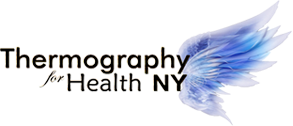Thermography has been called “the functional test that lets you see what you can’t feel,” and can spot potential problems before they become disease.
It uses an infrared camera (link to our previous article explaining thermography) to monitor skin blood flow and metabolic processes, without any radiation, pain or body contact. By analyzing your body’s heat flow, a health practitioner, such as myself, can see the tiniest abnormality, pre-cancerous condition, tumor changes, or infection. And the best thing? Thermography is pain free and noninvasive.
Airports are now even using thermal imaging to detect illness and fevers at airport checkpoints.
Recently, Gary Strahan, founder and CEO of Infrared Cameras, Inc. of Beaumont, TX told CNN that infrared cameras are two to three times more sensitive than normal surveillance cameras, making them particularly effective for airport, as well as, medical screenings. “Our results demonstrated that fever screening at airports is an effective means of identifying imported dengue (Fever) cases.” (link to article)
Thermography has a long history that has increased over the past fifty years. It is often used by firefighters to see through smoke to detect those who may be trapped in a blaze. Government and airport personnel used thermography to detect suspected swine flu cases during the 2009 pandemic.
It’s now used to screen for gum infections, heart disease, allergies, multiple sclerosis, stroke, high blood pressure, diabetes, and some types of cancers.
Often in the center of a hotly debated subject on mammograms, thermography allows physicians to detect abnormalities well before they develop, possibly reducing the amount of mis-diagnoses, over-diagnoses and needless radiation, while the mammogram detects a tumor only after it has developed into a full-blown cancer.
Thermography helps many people but is still a technology that most have never even heard of—share this article and let’s help spread the word!


